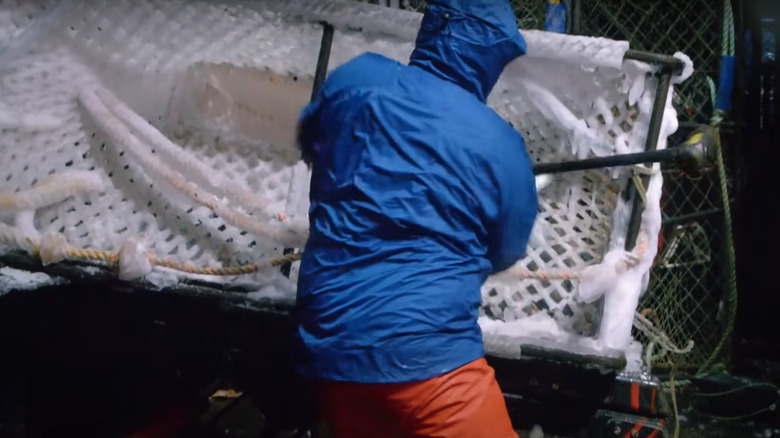Deadliest Catch's Edgar Hansen Explains The Struggle Of Getting Ice Off The Boat
If you ask the crew of each boat featured on Discovery's "Deadliest Catch" which factor of their job brings the most stress, you're sure to get different answers. The deckhands might say rogue waves pushing them overboard or getting hit with swinging 700-pound pots. The captains may answer with having a catastrophic mechanical failure or not catching enough crab to meet quota. No matter what they say is their top fear, there is one culprit that always presents not only frustrations but potentially fatal consequences — ice.
From the start of the series, it's been apparent to fans at home that for the crews of the "Deadliest Catch" fleet, there is nothing good about ice. Deckhand Edgar Hansen of the Northwestern — brother to captain Sig Hansen — talked about how the drifting ice can seriously derail a whole season's worth of profits. In an interview with the Viera Voice, Hanson explained what happens when the ice patches drift over their crab pots.
"Most likely they've been drug a mile or two off," Hansen said. "So, you could spend weeks looking for your gear." However, as financially crushing as this scenario would be for every ship out there trying to pull in a living, it's nowhere near as devastating as what ice can do when it decides to come on board.
The only way to beat the ice, is to beat the ice
The crew of each of the boats featured on "Deadliest Catch" all agree that there is one passenger that is never allowed to spend too much time on board, and that passenger is ice. On top of all the other potentially deadly factors these brave fishermen must endure, ice can lead to the deaths of each person on the boat. If not taken care of in time, the frozen salt water can accumulate across the deck, railings, and each one of the stacked crab pots. With all that added weight, according to Edgar Hanson, the boat can become top-heavy, and potentially capsize, causing further tragedy.
The good news is that ice is one factor that the crew can, at least, put effort into eliminating. When commenting on the potential amount of ice that can accumulate on surfaces, Hansen said, "They say that every inch of ice is worth a quarter of an inch of steel. So when you're talking 2, 3 feet thick of ice, you can imagine how heavier that boat load is." And the only way to get rid of this dangerous weight is to put in double the work, banging the ice off with huge mallets. "It's a nightmare. That's the straw that breaks the camel's back," Hansen said (via Viera Voice).
As frustrating and difficult as ice is to remove off these crab boats, it's a necessary task that can ensure an entire crew's survival. Most experienced fishermen who have made their way across the Bering Sea surely know that it is an unavoidable factor that must be knocked out in order to not only reap the rewards of a successful crab-catching season but also to live through it.

